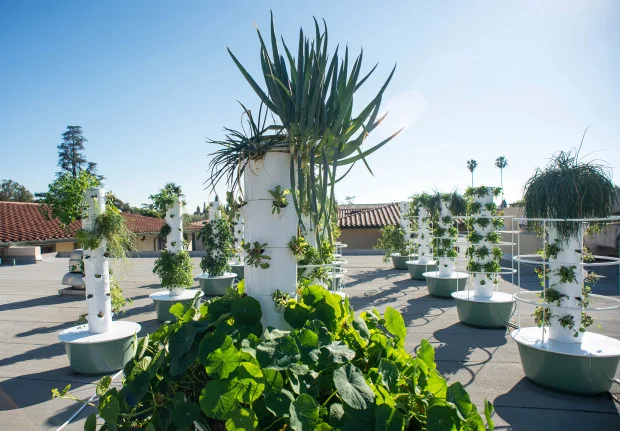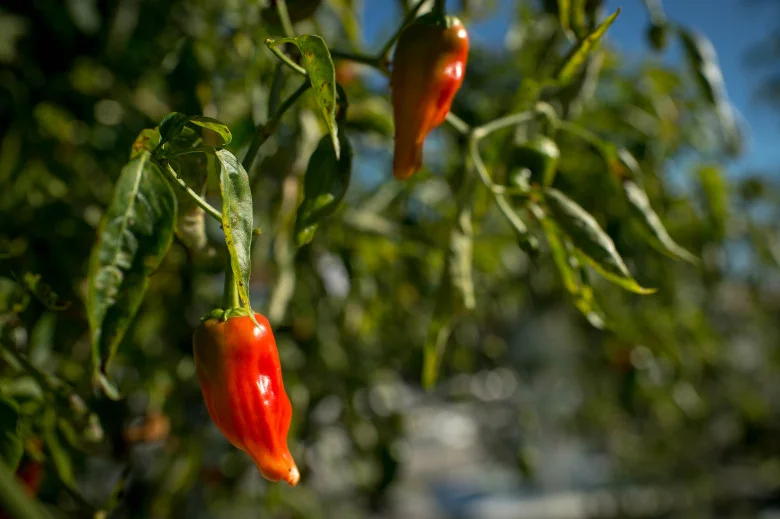This Caltech Dining Center’s Freshest Vegetables Are Grown On Its Roof
This Caltech Dining Center’s Freshest Vegetables Are Grown On Its Roof
Executive chef Zach Chambers, of Caltech Dining, walks through Caltech’s Chandler Cafe’s roof garden on Thursday, Jan. 11, 2018. The aeroponic towers are growing greens, mixed lettuces, chills, eggplants, onions, and herbs with the help of LA Urban Farms. (Photo by Sarah Reingewirtz, Pasadena Star-News/SCNG)
By JASON HENRY | jhenry@scng.com | Pasadena Star News
January 14, 2018 at 8:22 pm
The first course prepared for the most recent “Dress Dinner” at Caltech wasn’t unusual for the fancy, end-of-term meal for students, but the source of the mixed greens, flowers and other vegetables in the dish is a point of pride for executive chef Zach Chambers.
Forget farm-to-table, everything on the plate was grown on the dining hall’s roof.
“The whole first course this term was a mixed salad from up here,” Chambers said, standing among rows and rows of Tower Gardens, aeroponics systems installed by L.A.Urban Farms on theChandler Cafe‘s roof over the summer. The 48 towers, standing about 5 yo 6 feet tall, can each grow more than two dozens vegetables at once and they are easy enough for the cafe’s staff to harvest as needed.
(Photo by Sarah Reingewirtz, Pasadena Star-News/SCNG)
“We literally have a roof-to-table program here,” said Jonathan Webster, senior director of Caltech’s dining services.
Today, the garden grows peppers, eggplants, heads of lettuce, kale, arugula, basil and other herbs.
Webster wanted to make use of the cafe’s large rooftop, but he initially thought a traditional garden, with heavy soil, would weigh too much and require more attention than his staff could give. At a conference, he learned about the vertical Tower Gardens, which take up less than 3 square feet each. He found immediate support from his superiors because the students get better food, the dining center is more environmentally responsible and it might just save some money too.
The aeroponics system pumps water to the top of the tower and then drips it onto the roots of the plants for about 15 minutes every half an hour.
Eventually, most, if not all, of the water will come from condensation collected from the dining center’s air conditioning unit, Webster said. He also wants to have solar panels installed to generate the power needed for the pumps.
All of the food is utilized in the Chandler Cafe, a dining hall that serves more than 700 students each day. The chefs plan menus around what crops might be available up to three weeks advance. The forecasting allows them to plant more of a particular vegetable if they know they’ll need it in the future.
“That’s kind of the essence of cooking seasonally,” Chambers said. “One way or another, we’re going to make use of this stuff.”
When they didn’t have an immediate need for chilies they grew in the garden, the cooking staff turned the remainder into chili powder. A particularly large bounty of peppers was preserved for later use.
Chambers said at least one or two dishes each night contains something from the roof.
Caltech is known for its experimentation, and Webster said the institute’s kitchens are no exception.
There have been some unexpected hiccups. Birds destroyed a number of tomato plants in the beginning, prompting Webster buy a wooden owl to act as a scarecrow. There hasn’t been a problem since, he said.
Caltech spent about $24,000 on the towers, but the exact cost of the entire set up wasn’t available. The first 23 towers went up at the end of the last academic year; they added another 36 shortly before students returned this fall. There’s plenty of space left on the roof for an even larger garden if the initial experiment proves successful, Webster said.
Currently, every piece of produce is weighed and added to a spreadsheet to track what the kitchen is using compared to traditional vendors. He said the experiment has only been running for a few months, and it’s too early to determine the fiscal impact.
“The prospect of payback is there,” Webster said.









